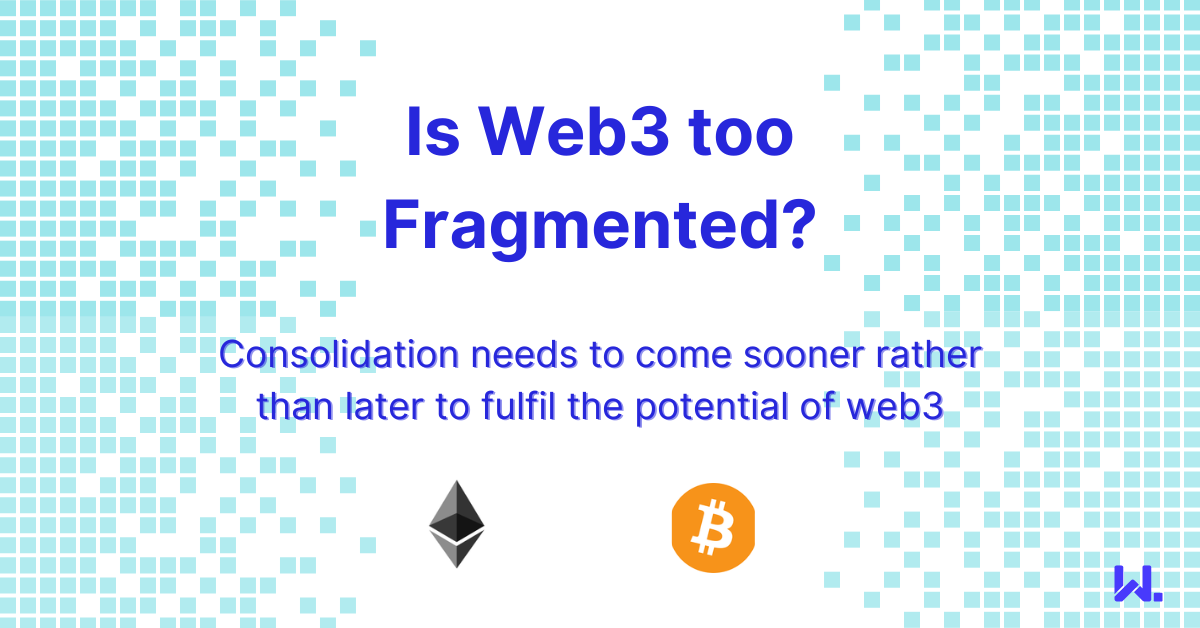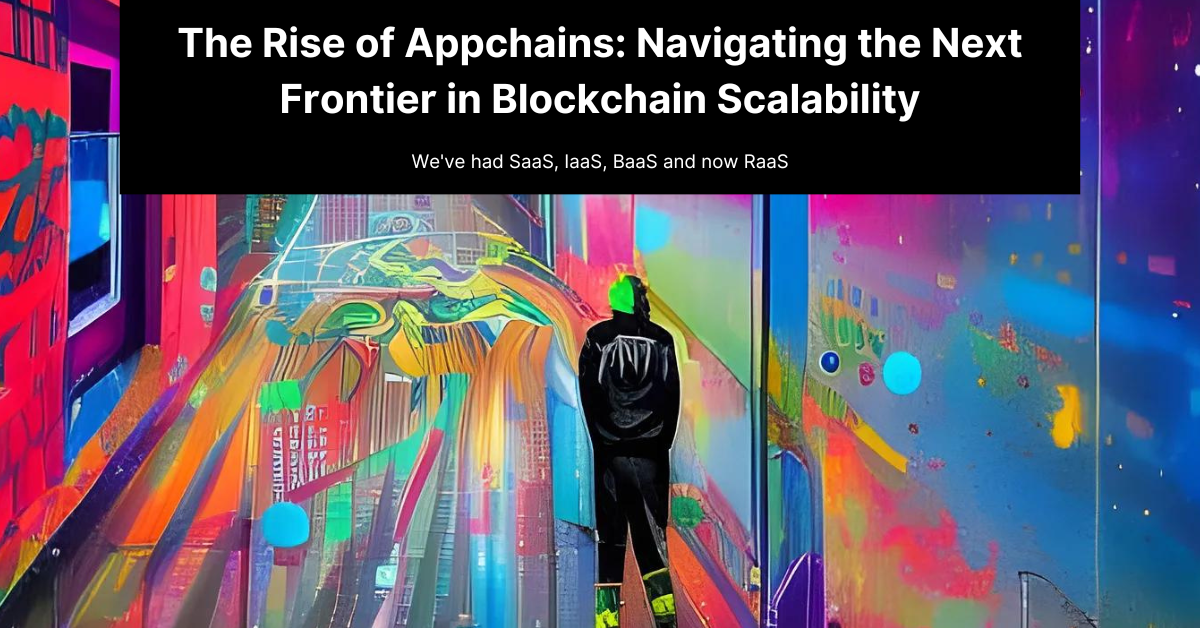Is Web3 too Fragmented?
Web3 has a problem. It's not the user experience, the lack of regulation, or even the prevalence of bots and scammers trying to steal people's crypto and NFTs. It's the fragmentation. Once upon a time, there was bitcoin, the world's first digital currency. Things were simpler, if you wanted to own a true, native digital asset, you bought bitcoin. In the subsequent years, some bitcoin alternatives emerged, but really there was just bitcoin and not much else.
Consolidation needs to come sooner rather than later to fulfil the potential of web3
Half a decade later, something new came along a brand new blockchain, which was so much more than a digital currency. It was a massively decentralised computer. Named Ethereum, it was a decentralised application platform. With the power of smart contracts, it enabled you not just to create your own new digital assets, but entirely new types of financial applications as well as systems using a new decentralised governance model.
Both Bitcoin and Ethereum thrived in the years following their launch, with proponents and users of these networks embracing their narratives of digital cash and decentralised computation respectively.
These supporters focussed their energies on building communities and valuable products and applications utilising these platforms. Others focussed on creating new abstractions to simplify their adoption, thus providing greater utility for their existing users and helping to onboard new users.
Whilst the popularity of these technologies has grown, some felt that these platforms provided too many shortcomings and that they could create a superior platform. This resulted in a number of new blockchain networks emerging in the years following bitcoin and Ethereum, all with a view to providing a faster/more scalable/etc alternative. This has been particularly acute with respect to Ethereum. The bitcoin competitors have generally been derivatives of bitcoin, with a few changes made by their creators.
Whereas in the case of the decentralised applications platforms, you have a number of alternative layer one networks (alt-layer1s) trying to position themselves as superior to Ethereum. This includes Binance Smart Chain, Cardano, Polkadot and Solana.
There are a number of great minds working on these alt-layer1 platforms, and they are very genuine with their intentions. The issue is how it fragments the web3 landscape, with the potential to slow down the overall adoption of blockchain and related technologies, and in some cases tarnish society's broader perception of web3.
In hindsight, it was incredibly fortunate that the U.S. Government created the Internet. Initially focussed on linking military and academic networks in the 1970s. By the time it was made available for private sector and public consumption, there was a network in place with proven technologies such as TCP/IP and DNS serving as its backbone. The barriers to entry for creating an alternative to the internet were too high, so entrepreneurs and businesses worked with this as their platform for innovation, which resulted in the creation of the world wide web, and all of the subsequent innovations and businesses that were built on top of it.
In the past couple of decades, we've seen software eating the world, with almost unlimited funding for companies from well-capitalised VCs. These funds have been used to create new internet-scale software platforms servicing an ever-increasing number of users and businesses (AWS, Google, etc).
What this has meant is in the context of web3, when a new founding team comes along and says they believe they can build a superior network to Ethereum, there are plenty of investors willing to throw money in the ring because:
-
The founding team has a unique angle and track record
-
Their business model is based on taking bets — they accept that only 7.5% of their investments will actually pay off
-
They see it as an opportunity to generate a potential 100-1000x return based on the return early crypto investors had
As a result of this, we're now in an environment where there are multiple public blockchain networks all vying for users, where equivalent infrastructure is being ported or rebuilt on all of these different networks.
Interoperability is also limited, where the transfer of assets between different platforms is clunky and comes with a number of risks — many of the major exploits in web3 have been via bridges between blockchains, which can be considered the Achilles heel of much of the public infrastructure.
We see it time and time again in software with technologists reinventing software frameworks, so this behaviour is not uncommon. But given the work required to create and run a public blockchain network successfully, plus the network effect required for it to succeed. The pragmatist inside me believes that we would be better served by teams focussing on the layers and abstractions that can be created on top of an existing base network instead of creating alternatives.
This would enable web3 to evolve far faster than it is at present. So many resources are being spent investing in alternatives and trying to bridge different platforms, that the perception of many onlookers is simply that web3 has become too fragmented to double down on one platform.
This harms innovation, as it leaves many watching from the sidelines to conclude that they should wait until the landscape consolidates before doubling down on one network or technology.
We're fortunate that Ethereum's Virtual Machine has become standardised across much of web3, which is fostering a lot of innovation in the space. But this is not enough. Imagine if when the internet was created instead of a single global network, you had multiple private entities competing to create their own global networks, each of them positioning themselves as superior to what had come before.
Instead of private enterprise focussing on building browsers and search engines, we'd have been stuck in the trenches with them all creating their own version of TCP/IP, or HTML and HTTP, with a lack of interoperability plaguing the wider adoptions of the technology.
This is the point it seems like we are in web3. There is an inevitability that we will see greater consolidation of platforms and protocols over time. Perhaps it's too optimistic to believe that we could standardise on just one public blockchain network with Ethereum as the primary settlement layer for web3, and Bitcoin retaining its position as digital gold.
This would allow other networks to remain in existence as layer two networks, that inherit the security guarantees of Ethereum. This approach would be beneficial for users of web3 who would have a consistent base platform across the board, and ensure that the primary focus of the layers that exist on top is to add ever-increasing capabilities and value for its users. Thus servicing the end user far better than we do currently, and helping web3 evolve faster to reach its true potential.
History is littered with examples of where the best technology didn't win, and we need to reach a point where we commit to building on top of what we've got. After all, what's the point in continually optimising something that has yet to reach its full potential?





